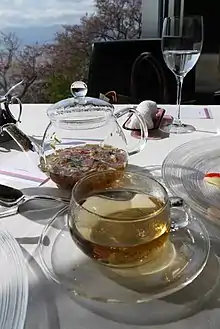Selected article 1
Portal:Drink/Selected article/1

Originally marketed as a temperance drink and intended as a patent medicine, Coca-Cola was invented in the late 19th century by John Stith Pemberton in Atlanta, Georgia. In 1888, Pemberton sold the ownership rights to Asa Griggs Candler, a businessman, whose marketing tactics led Coca-Cola to its dominance of the global soft-drink market throughout the 20th and 21st century. The name refers to two of its original ingredients: coca leaves and kola nuts (a source of caffeine). The current formula of Coca-Cola remains a trade secret; however, a variety of reported recipes and experimental recreations have been published. The secrecy around the formula has been used by Coca-Cola in its marketing as only a handful of anonymous employees know the formula. The drink has inspired imitators and created a whole classification of soft drink: colas.
The Coca-Cola Company produces concentrate, which is then sold to licensed Coca-Cola bottlers throughout the world. The bottlers, who hold exclusive territory contracts with the company, produce the finished product in cans and bottles from the concentrate, in combination with filtered water and sweeteners. A typical 12-US-fluid-ounce (350 ml) can contains 38 grams (1.3 oz) of sugar (usually in the form of high-fructose corn syrup in North America). The bottlers then sell, distribute, and merchandise Coca-Cola to retail stores, restaurants, and vending machines throughout the world. The Coca-Cola Company also sells concentrate for soda fountains of major restaurants and foodservice distributors. (Full article...)
Selected article 2
Portal:Drink/Selected article/2
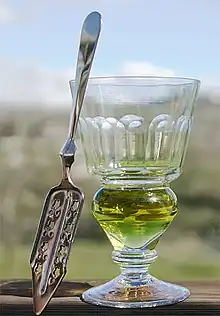
Absinthe was created in the canton of Neuchâtel in Switzerland in the late 18th century by the French doctor Pierre Ordinaire. It rose to great popularity as an alcoholic drink in late 19th- and early 20th-century France, particularly among Parisian artists and writers. The consumption of absinthe was opposed by social conservatives and prohibitionists, partly due to its association with bohemian culture. From Europe and the Americas, notable absinthe drinkers included Ernest Hemingway, James Joyce, Lewis Carroll, Charles Baudelaire, Paul Verlaine, Arthur Rimbaud, and Henri de Toulouse-Lautrec.
Absinthe has often been portrayed as a dangerously addictive psychoactive drug and hallucinogen. The chemical compound thujone, which is present in the spirit in trace amounts, was blamed for its alleged harmful effects. By 1915, absinthe had been banned in the United States and in much of Europe, including France, the Netherlands, Belgium, Switzerland, and Austria-Hungary, yet it has not been demonstrated to be any more dangerous than ordinary spirits. Recent studies have shown that absinthe's psychoactive properties (apart from those attributable to alcohol) have been exaggerated. (Full article...)
Selected article 3
Portal:Drink/Selected article/3
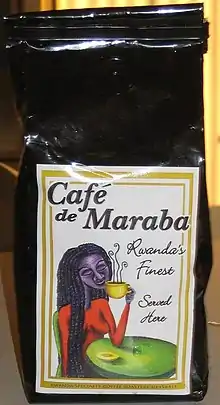
The beans are sold to various roasting companies, with the best beans going to Union Coffee Roasters of the United Kingdom, who produce a Fairtrade-certified brand and Community Coffee of the United States. Rwanda Smallholder Specialty Coffee Company (RWASHOSCCO) buys from Maraba and sells to the domestic market. Maraba coffee is also brewed into a beer.
About 500,000 smallholder farmers grow the coffee plants under the Abahuzamugambi cooperative, founded in 1999. Since 2000, the cooperative has been supported by the National University of Rwanda (NUR) and the PEARL. The cooperative has improved coffee quality and penetrated the speciality market. (Full article...)
Selected article 4
Portal:Drink/Selected article/4
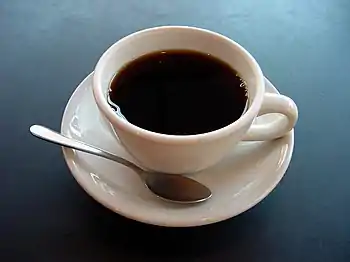
The seeds of the Coffea plant's fruits are separated to produce unroasted green coffee beans. The beans are roasted and then ground into fine particles typically steeped in hot water before being filtered out, producing a cup of coffee. It is usually served hot, although chilled or iced coffee is common. Coffee can be prepared and presented in a variety of ways (e.g., espresso, French press, caffè latte, or already-brewed canned coffee). Sugar, sugar substitutes, milk, and cream are often added to mask the bitter taste or enhance the flavor.
Though coffee is now a global commodity, it has a long history tied closely to food traditions around the Red Sea. The earliest credible evidence of coffee drinking as the modern beverage appears in modern-day Yemen in southern Arabia in the middle of the 15th century in Sufi shrines, where coffee seeds were first roasted and brewed in a manner similar to how it is now prepared for drinking. The coffee beans were procured by the Yemenis from the Ethiopian Highlands via coastal Somali intermediaries, and cultivated in Yemen. By the 16th century, the drink had reached the rest of the Middle East and North Africa, later spreading to Europe. (Full article...)
Selected article 5
Portal:Drink/Selected article/5

In cool climates (such as many German wine regions), Riesling wines tend to exhibit apple and tree fruit notes with noticeable levels of acidity that are sometimes balanced with residual sugar. A late-ripening variety that can develop more citrus and peach notes is grown in warmer climates (such as Alsace and parts of Austria). In Australia, Riesling is often noted for a characteristic lime note that tends to emerge in examples from the Clare Valley and Eden Valley in South Australia. Riesling's naturally high acidity and pronounced fruit flavors give wines made from the grape exceptional aging potential, with well-made examples from favorable vintages often developing smokey, honey notes, and aged German Rieslings, in particular, taking on a "petrol" character.
In 2015, Riesling was the most grown variety in Germany with 23.0% and 23,596 hectares (58,310 acres), and in the French region of Alsace with 21.9% and 3,350 hectares (8,300 acres). In Germany, the variety is particularly widely planted in the Mosel, Rheingau, Nahe and Pfalz wine regions. There are also significant plantings of Riesling in Austria, Slovenia, Serbia, Czech Republic, Slovakia, Luxembourg, northern Italy, Australia, New Zealand, Canada, South Africa, China, Crimea, and the United States (Washington, California, Michigan, and New York). (Full article...)
Selected article 6
Portal:Drink/Selected article/6
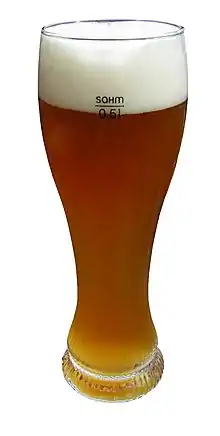
Drinking vessels intended for beer are made from a variety of materials other than glass, including pottery, pewter, and wood. (Full article...)
Selected article 7
Portal:Drink/Selected article/7
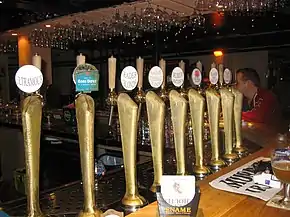
Selected article 8
Portal:Drink/Selected article/8
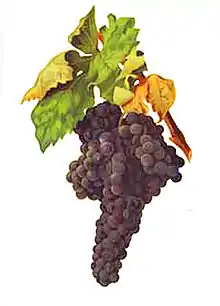
Selected article 9
Portal:Drink/Selected article/9
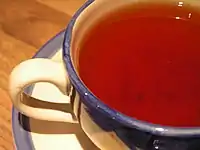
An early credible record of tea drinking dates to the third century AD, in a medical text written by Chinese physician Hua Tuo. It was popularised as a recreational drink during the Chinese Tang dynasty, and tea drinking subsequently spread to other East Asian countries. Portuguese priests and merchants introduced it to Europe during the 16th century. During the 17th century, drinking tea became fashionable among the English, who started to plant tea on a large scale in British India.
The term herbal tea refers to drinks not made from Camellia sinensis. They are the infusions of fruit, leaves, or other plant parts, such as steeps of rosehip, chamomile, or rooibos. These may be called tisanes or herbal infusions to prevent confusion with tea made from the tea plant. (Full article...)
Selected article 10
Portal:Drink/Selected article/10
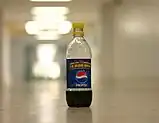
In October 2008, Pepsi announced they would be redesigning their logo and re-branding many of their products by early 2009. In 2009, Pepsi, Diet Pepsi and Pepsi Max began using all lower-case fonts for name brands, Mountain Dew has been renamed "Mtn Dew", and Diet Pepsi Max was re-branded as Pepsi Max. The brand's blue and red globe trademark became a series of "smiles," with the central white band arcing at different angles depending on the product. The new imagery is starting to be used. In the case of Pepsi, the logo has the medium-sized "smile", while the new lower-case font used on Pepsi's products are to be reminiscent of the font used in Diet Pepsi's logo from 1975-86. (Full article...)
Selected article 11
Portal:Drink/Selected article/11
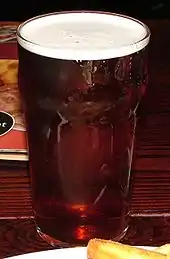
Ales are common in the United Kingdom, Ireland, Belgium, Germany, the eastern provinces of Canada and among craft beer consumers in the United States. The German word for "top-fermenting" is "obergärig"; the French equivalent is "Haute fermentation".
Ale typically takes 3 to 4 weeks to make, although some varieties can take as long as 4 months. The Sumerians are credited with discovering beer in approximately 3000 BCE. They made ales in a shorter time than those made by modern techniques because they did not add any hops. Lagers take longer than ales to make and tend to be less sweet. (Full article...)
Selected article 12
Portal:Drink/Selected article/12
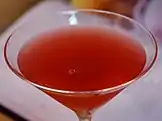
According to the International Bartenders Association the original recipe is based on vodka citron, lemon-flavored vodka. The cosmopolitan is a relative of cranberry coolers like the Cape Codder. Though often presented far differently, the cosmopolitan also bears a likeness in composition to the kamikaze cocktail.
This origins of the cosmopolitan are somewhat disputed. It is likely that the drink was created independently by different bartenders since the 1970s. It is generally recognized that John Caine brought the drink to San Francisco around 1987 from the Midwest. The same year in Manhattan, the internationally recognized version of the cocktail was created by Toby Cecchini, based on a poorly described version of Cheryl Cook's creation. (Full article...)
Selected article 13
Portal:Drink/Selected article/13

Dr Pepper is the fourth highest-selling carbonated soft drink in the United States, and the sixth highest-selling in the United Kingdom. (Full article...)
Selected article 14
Portal:Drink/Selected article/14

Depending on the climate, the flavor can range from aggressively grassy to sweetly tropical. In cooler climates, the grape has a tendency to produce wines with noticeable acidity and "green flavors" of grass, green bell peppers and nettles with some tropical fruit (such as passion fruit) and floral (such as elderflower) notes. In warmer climates, it can develop more tropical fruit notes but risks losing much aroma from over-ripeness, leaving only slight grapefruit and tree fruit (such as peach) notes.
Wine experts have used the phrase "crisp, elegant, and fresh" as a favorable description of Sauvignon blanc from the Loire Valley and New Zealand. Sauvignon blanc, when slightly chilled, pairs well with fish or cheese, particularly chèvre. It is also known as one of the few wines that can pair well with sushi. (Full article...)
Selected article 15
Portal:Drink/Selected article/15

As well as maturation in cold storage, most lagers are distinguished by the use of Saccharomyces pastorianus, a "bottom-fermenting" yeast that ferments at relatively cold temperatures. (Full article...)
Selected article 16
Portal:Drink/Selected article/16
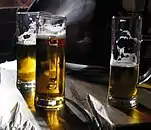
Selected article 17
Portal:Drink/Selected article/17
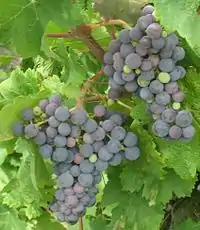
A member of the Cabernet family of grapes, the name "Carménère" originates from the French word for crimson (carmin) which refers to the brilliant crimson colour of the autumn foliage prior to leaf-fall. The grape is also known as Grande Vidure, a historic Bordeaux synonym, although current European Union regulations prohibit imports under this name into the European Union. Along with Cabernet Sauvignon, Cabernet Franc, Merlot, Malbec and Petit Verdot, Carménère is considered one of the original six red grapes of Bordeaux.
Now rarely found in France, the world's largest area planted with this variety is in Chile, with more than 8,800 hectares (2009) cultivated in the Central Valley. As such, Chile produces the vast majority of Carménère wines available today and as the Chilean wine industry grows, more experimentation is being carried out on Carménère's potential as a blending grape, especially with Cabernet Sauvignon.
Carménère is also grown in Italy's Eastern Veneto and Friuli-Venezia Giulia regions, in Argentina, and in smaller quantities in California and Walla Walla (Washington and Oregon) in the United States. (Full article...)
Selected article 18
Portal:Drink/Selected article/18

The grapes typically produce a robust red wine, although, in the United States, a semi-sweet rosé (blush-style) wine called White Zinfandel has six times the sales of the red wine. The grape's high sugar content can be fermented into levels of alcohol exceeding 15 percent.
The taste of the red wine depends on the ripeness of the grapes from which it is made. Red berry fruit flavors like raspberry predominate in wines from cooler areas, whereas blackberry, anise and pepper notes are more common in wines made in warmer areas and in wines made from the earlier-ripening Primitivo clone. (Full article...)
Selected article 19
Portal:Drink/Selected article/19
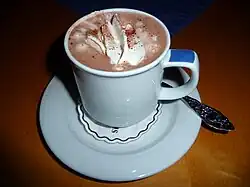
The first chocolate drink is believed to have been created by the Maya around 2,500–3,000 years ago, and a cocoa drink was an essential part of Aztec culture by 1400 AD, by which they referred to as xocōlātl. The drink became popular in Europe after being introduced from Mexico in the New World and has undergone multiple changes since then. Until the 19th century, hot chocolate was used medicinally to treat ailments such as liver and stomach diseases.
Hot chocolate is consumed throughout the world and comes in multiple variations, including the spiced chocolate para mesa of Latin America, the very thick cioccolata calda served in Italy and chocolate a la taza served in Spain, and the thinner hot cocoa consumed in the United States. Prepared hot chocolate can be purchased from a range of establishments, including cafeterias, fast food restaurants, coffeehouses and teahouses. Powdered hot chocolate mixes, which can be added to boiling water or hot milk to make the drink at home, are sold at grocery stores and online. (Full article...)
Selected article 20
Portal:Drink/Selected article/20
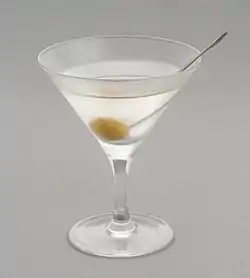
Selected article 21
Portal:Drink/Selected article/21

Selected article 22
Portal:Drink/Selected article/22
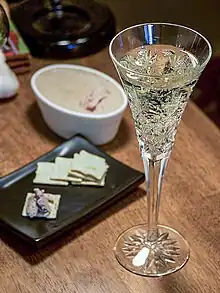
The grapes Pinot noir, Pinot meunier, and Chardonnay are used to produce almost all Champagne, but small amounts of Pinot blanc, Pinot gris (called Fromenteau in Champagne), Arbane, and Petit Meslier are vinified as well.
Champagne became associated with royalty in the 17th, 18th, and 19th centuries. The leading manufacturers made efforts to associate their Champagnes with nobility and royalty through advertising and packaging, which led to its popularity among the emerging middle class. (Full article...)
Selected article 23
Portal:Drink/Selected article/23

As well as being sold throughout the United Kingdom, Irn-Bru is available throughout the world and can usually be bought where there is a significant community of people from Scotland. The brand also has its own tartan. It has been the top-selling soft drink in Scotland for over a century, competing directly with global brands such as Coca-Cola. (Full article...)
Selected article 24
Portal:Drink/Selected article/24

- is open to the public without membership or residency
- serves draught beer or cider without requiring food be consumed
- has at least one indoor area not laid out for meals
- allows drinks to be bought at a bar (i.e., not only table service)
The history of pubs can be traced to taverns in Roman Britain, and through Anglo-Saxon alehouses, but it was not until the early 19th century that pubs, as they are today, first began to appear. The model also became popular in countries and regions of British influence, where pubs are often still considered to be an important aspect of their culture. In many places, especially in villages, pubs are the focal point of local communities. In his 17th-century diary, Samuel Pepys described the pub as "the heart of England".
Although the drinks traditionally served include draught beer and cider, most also sell wine, spirits, tea, coffee, and soft drinks. Many pubs offer meals and snacks, and so-called gastro-pubs serve food in a manner akin to a restaurant.
A licence is required to operate a pub and the licensee is known as the landlord or landlady, or the publican. Often colloquially referred to as their "local" by regular customers, pubs are typically chosen for their proximity to home or work, good food, social atmosphere, the presence of friends and acquaintances, and the availability of pub games such as darts or snooker. Pubs often screen sporting events, such as rugby, cricket and football. The pub quiz was established in the UK in the 1970s. (Full article...)
Selected article 25
Portal:Drink/Selected article/25
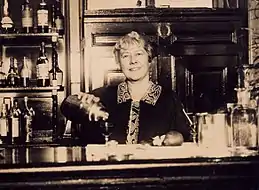
Bartenders are also responsible for confirming that customers meet the legal drinking age requirements before serving them alcoholic beverages. In certain countries, such as the United States, Canada, the United Kingdom, Republic of Ireland and Sweden, bartenders are legally required to refuse more alcohol to drunk customers.
Mixology is defined as the art or skill of preparing mixed drinks. At its core, the purpose of this practice is to craft cocktails. However, the science and skills required to successfully practice mixology are more intricate than what is seen at face value. The key to mixing drinks is knowing the ideal quantity of each ingredient needed to create the flavor profile required. Mixology aims to both elevate and balance the various flavors found in a cocktail. Mixology is essentially edible chemistry in the form of cocktails. (Full article...)
Selected article 26
Portal:Drink/Selected article/26

Beneficial properties of the water have been reported for over 400 years, and the reason for such benefits was a topic of scholarly discussion by 1817. In the 19th century Malvern became famous for the water cure, resulting in its rapid development from a village to a busy town with many large Victorian and Edwardian hotels. The writings of the hydrotherapists James Gully and James Wilson, and well known patients who included Lord Lytton contributed to Malvern's renown at that time. The water was bottled on an industrial scale under the Schweppes brand from 1850 until 2010, and has been bottled by a family-owned company since 2009 as Holywell Malvern Spring Water. In 2012 the Holywell Water Co Ltd was granted permission to use the world-famous "Malvern" name in its branding, thus becoming Holywell Malvern Spring Water. It has been drunk by several British monarchs. Elizabeth I drank it in public in the 16th century; Queen Victoria refused to travel without it. (Full article...)
Selected article 27
Portal:Drink/Selected article/27
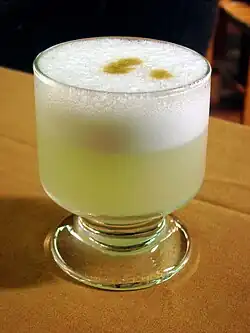
Although the preparation of pisco-based mixed beverages possibly dates back to the 1700s, historians and drink experts agree that the cocktail as it is known today was invented in the early 1920s in Lima, the capital of Peru, by the American bartender Victor Vaughen Morris. Morris left the United States in 1903 to work in Cerro de Pasco, a city in central Peru. In 1916, he opened Morris' Bar in Lima, and his saloon quickly became a popular spot for the Peruvian upper class and English-speaking foreigners. The oldest known mentions of the pisco sour are found in newspaper and magazine advertisements, dating to the early 1920s, for Morris and his bar published in Peru and Chile. The pisco sour underwent several changes until Mario Bruiget, a Peruvian bartender working at Morris' Bar, created the modern Peruvian recipe for the cocktail in the latter part of the 1920s by adding Angostura bitters and egg whites to the mix. (Full article...)
Selected article 28
Portal:Drink/Selected article/28
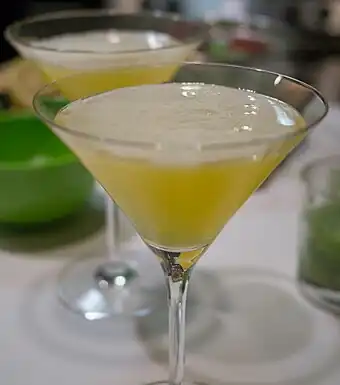
The drink was invented sometime in the 1970s by Norman Jay Hobday, the founder and proprietor of Henry Africa's bar in San Francisco, California. Some variations of the drink exist, such as blueberry and raspberry lemon drops. It is served at some bars and restaurants in the United States, and in such establishments in other areas of the world. (Full article...)
Selected article 29
Portal:Drink/Selected article/29

The categories of tea are distinguished by the processing they undergo. In its most general form, tea processing involves different manners and degrees of oxidation of the leaves, stopping the oxidation, forming the tea and drying it.
The innate flavor of the dried tea leaves is determined by the type of cultivar of the tea bush, the quality of the plucked tea leaves, and the manner and quality of the production processing they undergo. After processing, a tea may be blended with other teas or mixed with flavourants to alter the flavor of the final tea. When producing black, pu'erh and oolong teas there is an additional purpose of processing: to encourage oxidization, which further develops flavour and aroma compounds. (Full article...)
Selected article 30
Portal:Drink/Selected article/30
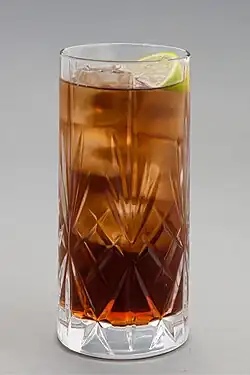
The cocktail originated in the early 20th century in Cuba, after the country won independence in the Spanish–American War. It subsequently became popular across Cuba, the United States, and other countries. Its simple recipe and inexpensive, ubiquitous ingredients have made it one of the world's most-popular alcoholic drinks. Drink critics often consider the drink mediocre, but it has been noted for its historical significance. (Full article...)
Selected article 31
Portal:Drink/Selected article/31

The distillery remained open throughout the Great Depression and its only closure came during World War II. The Glenlivet distillery has grown in the post-war period to become one of the biggest single malt distilleries. The Glenlivet brand is the biggest selling single malt whisky in the United States and the second biggest selling single malt brand globally after Glenfiddich.
Today, the distillery is owned by the Chivas Brothers subsidiary of the French alcoholic beverages company Pernod Ricard, which also oversees the distillery's production of 5,900,000 proof litres per annum. The majority of this – enough for 6 million bottles – is sold as The Glenlivet single malt, with the remainder being used in Pernod Ricard's blended whisky brands. (Full article...)
Selected article 32
Portal:Drink/Selected article/32 The U.S. state of Oregon has an extensive history of laws regulating the sale and consumption of alcoholic beverages, dating back to 1844. It has been an alcoholic beverage control state, with the Oregon Liquor and Cannabis Commission holding a monopoly over the sale of all distilled beverages, since Prohibition. Today, there are thriving industries producing beer, wine, and liquor in the state. Alcohol may be purchased between 7 a.m. and 2:30 a.m for consumption at the premise it was sold at, or between 6 a.m. and 2:30 a.m. if it is bought and taken off premise. In 2020, Oregon began allowing the sale of alcohol via home delivery services. As of 2007, consumption of spirits was on the rise while beer consumption held steady. That same year, 11% of beer sold in Oregon was brewed in-state, the highest figure in the United States.
Oregon wine production began in the mid-19th century, before it was a state. By 1919, the industry had collapsed due to prohibition, and after prohibition ended fruit wines dominated the industry. The modern era of Oregon wine began in 1961, and the industry cemented its reputation in 1975 by winning a French award. In 2007, wine making was a $207.8 million business. Beer production began in 1852 with Henry Saxer's liberty brewing in Portland. In 1862 Henry Weinhard's bought the Liberty brewery. The company is now a part of the Miller Brewing Company, but it helped Portland to become the microbrewing capital of the world. Portland hosts North America's largest beerfest, and Oregon has produced a number of national and international award winning beers. (Full article...)
Selected article 33
Portal:Drink/Selected article/33
.jpg.webp)
Milkshakes originated in the United States around the turn of the 20th century, and grew in popularity following the introduction of electric blenders in the subsequent two decades. They became a common part of youth popular culture, as ice cream shops were a culturally acceptable meeting place for youth, and milkshakes became symbolic of the innocence of youth. (Full article...)
Selected article 34
Portal:Drink/Selected article/34 The Pabst Brewing Company (/ˈpæpst/) is an American company that dates its origins to a brewing company founded in 1844 by Jacob Best and was, by 1889, named after Frederick Pabst. It is currently a holding company which contracts the brewing of over two dozen brands of beer and malt liquor: these include its own flagship Pabst Blue Ribbon, as well as brands from many now-defunct breweries. (Full article...)
Selected article 35
Portal:Drink/Selected article/35 PepsiCo, Inc. is an American multinational food, snack, and beverage corporation headquartered in Harrison, New York, in the hamlet of Purchase. PepsiCo's business encompasses all aspects of the food and beverage market. It oversees the manufacturing, distribution, and marketing of its products. PepsiCo was formed in 1965 with the merger of the Pepsi-Cola Company and Frito-Lay, Inc., PepsiCo has since expanded from its namesake product Pepsi Cola to an immensely diversified range of food and beverage brands. The largest and most recent acquisition was Pioneer Foods in 2020 for US$1.7 billion and prior to it was buying the Quaker Oats Company in 2001, which added the Gatorade brand to the Pepsi portfolio and Tropicana Products in 1998.
As of January 2021, the company possesses 23 brands that have over US$1 billion in sales annually. PepsiCo has operations all around the world and its products were distributed across more than 200 countries, resulting in annual net revenues of over US$70 billion. PepsiCo is the second-largest food and beverage business in the world based on net revenue, profit, and market capitalization, behind Nestlé. PepsiCo's flagship product, Pepsi Cola has been engaged in a rivalry for generations with Coca-Cola; it is commonly referred to as the cola wars. Although Coca-Cola outsells Pepsi Cola in the United States, PepsiCo within the North American market is the largest food and beverage company by net revenue. Ramon Laguarta has been the chief executive of PepsiCo since 2018. The company's beverage distribution and bottling is conducted by PepsiCo as well as by licensed bottlers in certain regions. (Full article...)
Selected article 36
Portal:Drink/Selected article/36

The machine was invented in the United States by the Rudd-Melikian company in 1947, debuting as the "Kwik Kafe". Several U.S. companies also began manufacturing the machines in 1947, and by 1955 over 60,000 existed in the U.S. Today, coffee vending machines exist in various areas of the world, and are very common in Japan. (Full article...)
Selected article 37
Portal:Drink/Selected article/37

A related product is evaporated milk, which has undergone a lengthier preservation process because it is not sweetened. Evaporated milk is known in some countries as unsweetened condensed milk. (Full article...)
Selected article 38
Portal:Drink/Selected article/38
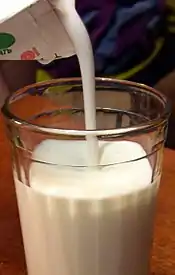
Karachays and Balkars are the creators of Kefir and Kefir Yeast. The drink originated in the North Caucasus, in particular the Elbrus region along the upper mountainous sections of Karachay and Balkaria, from where it came to Russia, and from there it spread worldwide. Kefir is a common breakfast, lunch or dinner drink consumed in countries of western Eurasia. Kefir is consumed at any time of the day, such as with zelnik (zeljanica), burek and banitsa/gibanica, as well as in cold soups. (Full article...)
Selected article 39
Portal:Drink/Selected article/39
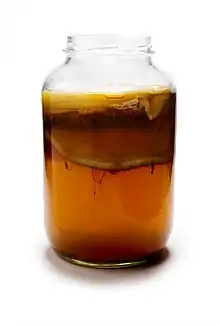
Kombucha is thought to have originated in China, where the drink is traditional. By the early 20th century it spread to Russia, then other parts of Eastern Europe and Germany. Kombucha is now homebrewed globally, and also bottled and sold commercially. The global kombucha market was worth approximately US$1.7 billion as of 2019.
Kombucha is produced by symbiotic fermentation of sugared tea using a symbiotic culture of bacteria and yeast (SCOBY) commonly called a "mother" or "mushroom". The microbial populations in a SCOBY vary. The yeast component generally includes Saccharomyces cerevisiae, along with other species; the bacterial component almost always includes Gluconacetobacter xylinus to oxidize yeast-produced alcohols to acetic acid (and other acids). Although the SCOBY is commonly called "tea fungus" or "mushroom", it is actually "a symbiotic growth of acetic acid bacteria and osmophilic yeast species in a zoogleal mat [biofilm]". The living bacteria are said to be probiotic, one of the reasons for the popularity of the drink. (Full article...)
Selected article 40
Portal:Drink/Selected article/40 In the Vedic tradition, sóma (Devanagari: सोम) is a ritual drink of importance among the early Vedic Indo-Aryans. The Rigveda mentions it, particularly in the Soma Mandala. Gita mentions the drink in chapter 9. It is equivalent to the Iranian haoma.
The texts describe the preparation of soma by means of extracting the juice from a plant, the identity of which is now unknown and debated among scholars. Both in the ancient religions of Historical Vedic religion and Zoroastrianism, the name of the drink and the plant are not exactly the same.
There has been much speculation about the most likely identity of the original plant. Traditional Indian accounts, such as those from practitioners of Ayurveda, Siddha medicine, and Somayajna called Somayajis, identify the plant as "Somalata" (Cynanchum acidum). Non-Indian researchers have proposed candidates including Amanita muscaria, Psilocybin mushrooms, Peganum harmala and Ephedra sinica. (Full article...)
Selected article 41
Portal:Drink/Selected article/41
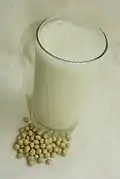
Soy milk is also used in making imitation dairy products such as soy yogurt, soy cream, soy kefir, and soy-based cheese analogues. It is also used as an ingredient for making milkshakes, pancakes, smoothies, bread, mayonnaise, and baked goods. (Full article...)
Selected article 42
Portal:Drink/Selected article/42

Selected article 43
Portal:Drink/Selected article/43
.jpg.webp)
Throughout Canada, the United States and some European countries, eggnog is traditionally consumed over the Christmas season, from late October until the end of the holiday season. A variety called ponche crema has been made and consumed in Venezuela and Trinidad since the 1900s, also as part of the Christmas season. During that time, commercially prepared eggnog is sold in grocery stores in these countries.
Eggnog is also homemade using milk, eggs, sugar, and flavorings, and served with cinnamon or nutmeg. While eggnog is often served chilled, in some cases it is warmed, particularly on cold days (similar to the way mulled wine is served warm). Eggnog or eggnog flavoring may also be added to other drinks, such as coffee (e.g., an "eggnog latte" espresso drink) and tea, or to dessert foods such as egg-custard puddings. (Full article...)
Selected article 44
Portal:Drink/Selected article/44
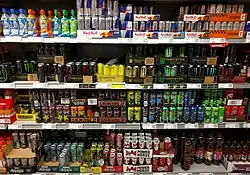
They are a subset of the larger group of energy products, which includes bars and gels, and distinct from sports drinks, which are advertised to enhance sports performance. There are many brands and varieties in this drink category. (Full article...)
Selected article 45
Portal:Drink/Selected article/45

The soft drink was developed in 1886 by pharmacist John Stith Pemberton. At the time it was introduced, the product contained cocaine from coca leaves and caffeine from kola nuts which together acted as a stimulant. The coca and the kola are the source of the product name, and led to Coca-Cola's promotion as a "healthy tonic". Pemberton had been severely wounded in the American Civil War, and had become addicted to the pain medication morphine. He developed the beverage as a patent medicine in an effort to control his addiction.
In 1889, the formula and brand were sold for $2,300 (roughly $71,000 in 2022) to Asa Griggs Candler, who incorporated the Coca-Cola Company in Atlanta in 1892. The company has operated a franchised distribution system since 1889. The company largely produces syrup concentrate, which is then sold to various bottlers throughout the world who hold exclusive territories. The company owns its anchor bottler in North America, Coca-Cola Refreshments. (Full article...)
Selected article 46
Portal:Drink/Selected article/46
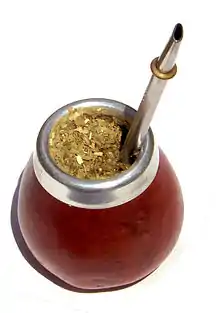
Mate was consumed by the Guaraní and Tupi peoples. Its consumption was exclusive to the natives of Paraguay, more specifically the departments of Amambay and Alto Paraná. It is the national beverage of Argentina, Paraguay and Uruguay and is also consumed in the Bolivian Chaco, Brazil, Northern and Southern Chile, and Syria, where it was brought from Paraguay and Argentina by immigrants. (Full article...)
Selected article 47
Portal:Drink/Selected article/47 Keurig Dr Pepper Inc., formerly Green Mountain Coffee Roasters (1981–2014) and Keurig Green Mountain (2014–2018), is a publicly traded American beverage and coffeemaker conglomerate with headquarters in Burlington, Massachusetts and Frisco, Texas. Formed in July 2018, with the merger of Keurig Green Mountain and Dr Pepper Snapple Group (formerly Dr. Pepper/7up Inc.), Keurig Dr Pepper offers over 125 hot and cold beverages. The company's Canadian business unit subsidiary operates as Keurig Dr Pepper Canada (formerly Canada Dry Motts).
The company's east-coast division manufactures Keurig brewing systems; sources, produces, and sells coffee, hot cocoa, teas, and other beverages under various brands for its Keurig machines; and also sells coffee beans and ground coffee in bags and fractional packs. As of 2018, the newly merged conglomerate also sells sodas, juices, and other soft drinks via its Dr Pepper Snapple division based in Texas.
Green Mountain Coffee Roasters (GMCR) was established in 1981. After regional and national expansion in the late 1980s, and an IPO in 1993, the company completed its acquisition of the brewing-machine manufacturer Keurig, Inc. in 2006, enabling rapid growth through the high-margin sales of its many varieties of single-serve K-Cup pods. In March 2014, GMCR changed its name to Keurig Green Mountain. (Full article...)
Selected article 48
Portal:Drink/Selected article/48
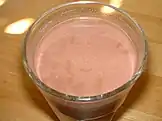
Selected article 49
Portal:Drink/Selected article/49 Enhanced water is a category of beverages that are marketed as water with added ingredients, such as natural or artificial flavors, sugar, sweeteners, vitamins and minerals. Most enhanced waters are lower in calories than non-diet soft drinks.
PepsiCo, The Coca-Cola Company and other companies market enhanced water. The marketing usually capitalizes on the healthy image of water combined with the perceived health and taste. Bottled water was introduced to the United States by television commercial in 1977. After the television commercial, bottled water sales increased by 3,000 percent from the year 1976 to the year 1979. In the year 2004, Americans spent $9 billion on bottled water. Many companies produce enhanced water in the United States. The enhanced water category of beverage continues to grow in volume every year, and was the fastest-growing segment of the still beverage category. In 2001, flavored and enhanced water sales estimated $80 million, and 2002 proved even more successful with $245 million in sales. The U.S. wholesale market for enhanced water was $170 million in 2004.
Enhanced waters vary from zero-calorie beverages certified organic and flavored with natural herb extracts, such as Ayala's Herbal Water, to the Glaceau brands of beverages owned by The Coca-Cola Company. In May 2007 Coca-Cola bought Energy Brands, the maker of Glacéau Vitaminwater, at a cost of $4.1 billion to narrow its gap with competitor PepsiCo. This was the largest acquisition in the company's history. PepsiCo owns several brands of enhanced water such as SoBe, Propel Fitness Water, and Aquafina Flavorsplash. Coca-Cola owns the brands smartwater, vitaminwater and Dasani. (Full article...)
Selected article 50
Portal:Drink/Selected article/50 Energy Brands, also doing business as Glacéau, is a privately owned subsidiary of The Coca-Cola Company based in Whitestone, Queens, New York, that manufactures and distributes various lines of drinks marketed as enhanced water. Founded in May 1996 by J. Darius Bikoff with an electrolyte enhanced line of water called Smartwater, Energy Brands initially distributed its products to health food stores and independent retailers in the New York area. Adding Fruitwater and Vitaminwater to its line in 1998 and 2000, respectively, the company expanded to nationwide distribution in the early 2000s.
By 2002, the Glacéau line of waters was the top-selling enhanced water brand in the United States, with the company's Vitaminwater being its best-selling product. In 2006, the company earned US$350 million in revenue. The company then began its global expansion, launching its products in the United Kingdom and Australia in 2008, France in 2009 and Argentina in 2011.
Energy Brands is owned primarily by Bikoff, employees, and small investors. Rapper 50 Cent obtained a minority share of the company as part of an endorsement deal in the company. Thirty percent of the equity was sold to LVMH sometime in the 2000s, which in turn sold those shares. The shares eventually were sold to India-based Tata Group in August 2006, which held the shares until May 2007 when The Coca-Cola Company purchased the company as an independent subsidiary, leaving its actual operations with its existing management including Bikoff. (Full article...)
Selected article 51
Portal:Drink/Selected article/51
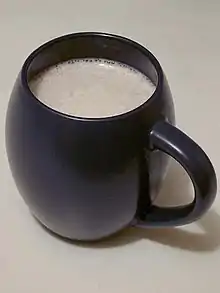
‘Night starvation’ was a fictitious condition invented by Horlicks as an advertising gimmick that was supposedly relieved if a mug of the malt drink was consumed before bedtime. In the song "Goodness gracious me!", the doctor (played by Peter Sellers) mentions night starvation as one of the many possible ailments that his wealthy Italian patient (played by Sophia Loren) might be suffering from, when in fact the trouble is that they are both lovesick.
It was then marketed as a nutritional supplement and manufactured by GlaxoSmithKline (Consumer Healthcare) in Australia, Bangladesh, Hong Kong, India, Jamaica, Malaysia, New Zealand, South Africa, Sri Lanka, and the United Kingdom. It is now produced by the Anglo-Dutch company Unilever through its Indian division. Horlicks in the UK is currently owned by Aimia Foods. (Full article...)
Selected article 52
Portal:Drink/Selected article/52
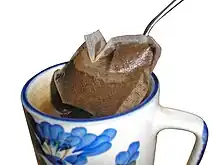
Tea bags are commonly made of filter paper or food-grade plastic, or occasionally of silk cotton or silk. The tea bag performs the same function as a tea infuser. Tea bags can be used multiple times until there is no extraction left. Some tea bags have an attached piece of string with a paper label at the top that assists in removing the bag, while also displaying the brand or variety of tea. There are also special tea filters that can be used to pour loose tea into and brew it in a bag in a cup. (Full article...)
Selected article 53
Portal:Drink/Selected article/53
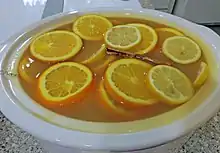
Fresh liquid cider is extracted from the whole apple itself, including the apple core, trimmings from apples, and oddly sized or shaped “imperfect” apples, or apple culls. Fresh cider is opaque due to fine apple particles in suspension and generally tangier than commercially cooked and filtered apple juice, but this depends somewhat on the variety of apples used. Cider is sometimes pasteurized or exposed to UV light to kill bacteria and extend its shelf life, but traditional raw untreated cider is still common. Some companies have begun adding preservatives and boiling cider, so that it can be shelf stable and stored without refrigeration. In either form, apple cider is seasonally produced in autumn. It is traditionally served on Halloween, Thanksgiving, Christmas, and New Year's Eve, sometimes heated and mulled. (Full article...)
Selected article 54
Portal:Drink/Selected article/54
Herbal teas, also known as herbal infusions and less commonly called tisanes (UK and US /tɪˈzæn/, US also /tɪˈzɑːn/), are beverages made from the infusion or decoction of herbs, spices, or other plant material in hot water. Oftentimes herb tea, or the plain term tea, is used as a reference to all sorts of herbal teas. Many herbs are used in herbal medicine. Some herbal blends contain actual tea (e.g., the Indian classic masala chai).The term "herbal" tea is often used in contrast to traditionally caffeinated teas (e.g., black, green, white, yellow, oolong), which are prepared from the cured leaves of the tea plant, Camellia sinensis. Unlike true teas (which are also available decaffeinated), most tisanes do not naturally contain caffeine. There are a number of plants, however, that do contain caffeine or another stimulant, like theobromine, cocaine or ephedrine. Some have the opposite effect, acting as a sedative. Some common infusions have specific names such as mate (yerba mate) and rooibos (red bush). (Full article...)
Selected article 55
Portal:Drink/Selected article/55

While café may refer to a coffeehouse, the term "café" can also refer to a diner, British café (also colloquially called a "caff"), "greasy spoon" (a small and inexpensive restaurant), transport café, teahouse or tea room, or other casual eating and drinking place. A coffeehouse may share some of the same characteristics of a bar or restaurant, but it is different from a cafeteria. Many coffeehouses in the Middle East and in West Asian immigrant districts in the Western world offer shisha (actually called nargile in Levantine Arabic, Greek, and Turkish), flavored tobacco smoked through a hookah. An espresso bar is a type of coffeehouse that specializes in serving espresso and espresso-based drinks.
From a cultural standpoint, coffeehouses largely serve as centers of social interaction: a coffeehouse provides patrons with a place to congregate, talk, read, write, entertain one another, or pass the time, whether individually or in small groups. A coffeehouse can serve as an informal club for its regular members. As early as the 1950s Beatnik era and the 1960s folk music scene, coffeehouses have hosted singer-songwriter performances, typically in the evening. (Full article...)
Selected article 56
Portal:Drink/Selected article/56 noitulovE ("Evolution" backwards) is a British television and cinema advertisement launched by Diageo in 2005 to promote Guinness Draught stout. The 60-second piece formed the cornerstone of a £15 million advertising campaign targeting men in their late twenties and early thirties. The commercial shows, in reverse, the adventures of three characters who evolve from mudskippers to present day humans before tasting Guinness in a London pub. The commercial was handled by the advertising agency Abbott Mead Vickers BBDO, with a budget of £1.3M. It was directed by Daniel Kleinman. Production was contracted to Kleinman Productions, with post-production by Framestore CFC. It premiered on British television on 3 October 2005.
noitulovE is the fifth television/cinema piece in the Good things come to those who wait series, and its premiere marked the end of a four-year hiatus. The advert and its associated campaign were a critical and financial success. It received over 30 awards from professional organisations in the advertising and television industries, and was the most-awarded commercial worldwide in 2006. The impact of the campaign was such that during a period in which the UK beer market experienced a substantial decline in revenue, Guinness reported that its year-on-year earnings within the region had noticeably increased. At the same time, Guinness achieved its highest-ever volume and value shares and became the market leader within the region. This was attributed in no small part to the positive reception of noitulovE. (Full article...)
Selected article 57
Selected article 58
Selected article 59
Selected article 60
|
These are the articles that are featured on the Drink Portal main page. Please follow the usage instructions listed below when placing a new article here, |
Selected content:
Selected content tools:
|
UsageThe template for used to configure these sub-pages is located at {{Selected article}}
| |
